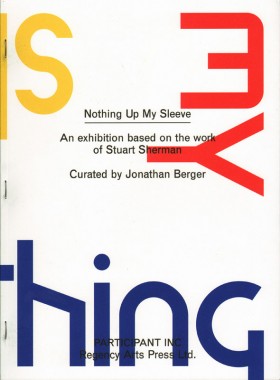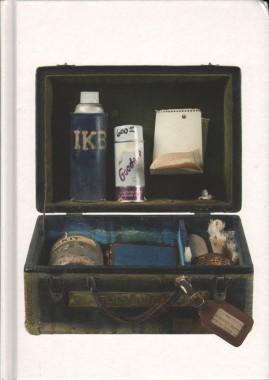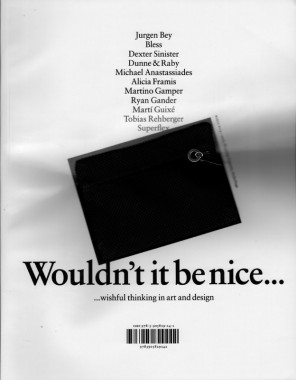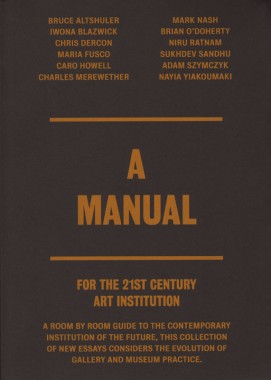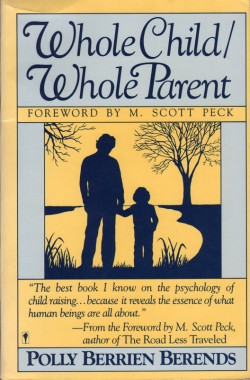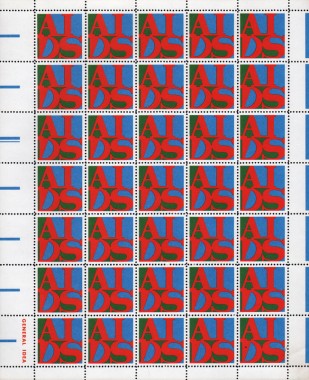Nothing Up My Sleeve
Jonathan Berger, Nothing Up My Sleeve
Softcover, 160 pp., offset 4/1, 8.5 x 11.5 inches
Edition of 1000
ISBN 978-098023-241-7
Published by Regency Arts Press, Participant Inc.
$20.00 ·
Berger paired the work of Stuart Sherman, a brilliant performance artist who died in 2001, with other performers and artists whose work, while not directly affected by Sherman, shares a similar spirit and exploration of authenticity. The book is an extension of the exhibition, composed of entries from each performer/artist included in the show: Matthew Brannon, Carol Bove, James Lee Byars, Vaginal Davis, Harry Houdini, Andy Kaufman, and several others. Reprinted in the book, with new commentary, are two early critical texts about Stuart Sherman’s spectacle works, by John Matturri (written in 1978), and Berenice Reynaud (published in issue eight of October art journal, 1979). There are also texts by Lia Gangitano, Jonathan Berger, Molly McGarry, and Mark Bradford.
Double Page
Christoph Keller and Jérôme Saint-Loubert Bié, Double Page
Softcover, 256 pp., offset 4/3, 115 x 160 mm
Edition of 2000
ISBN 978-2917855-06-5
Published by Editions B42
$15.00 · out of stock
This book is based on an invitation to graphic designers to choose two books on contemporary art from the past decade whose design they think is particularly pertinent to the content, to photograph one double-page spread from each book and, if they wish, to comment on their choices.
Double Page provides a selection of recent art publications as viewed by graphic designers who are internationally known for their contribution to that field, and offers a glimpse at the role of book design today in our knowledge and understanding of contemporary art.
Shedding light on this prevalent relationship between art and graphic design by means of photography, Double Page constitutes an unprecedented document of how graphic designers see the work of their peers and their own practices as an essential part of the editorial process.
Yves Klein: USA
Robert Pincus-Witten and Rotraut Klein-Moquay, Yves Klein: USA
Hardcover, 204 pp., offset 4/1, 176 x 242 mm
Edition of 2000
ISBN 978-291627-564-2
Published by Editions Dilecta
$32.00 · out of stock
In the spring of 1961, Yves Klein and his fiancee Rotraut Uecker, a distinguished artist herself, were en route to New York City. Leo Castelli, a leading American art dealer, had scheduled an exhibition of the work of “Yves le Monochrome” (as the painter had styled himself), to begin on April 11th. The exhibition marked Klein’s first solo show in the United States and its closing, set for the 29th of that month, virtually coincided with the artist’s thirty-third birthday, celebrated just the day before.
At the time, apart from the focus of a circle of fellow artists, noted critics and European dealers, a few alert collectors and many incensed detractors, Klein was still far from being recognized as the most influential artist to have emerged in postwar France — as he is regarded today; nor would one even dream that in scarcely more than a year he would be dead.
Wouldn’t it be nice
Katya Garcia-Anton and Emily King, Wouldn’t it be nice
Softcover, 300 pp., offset 4/1, 232 x 297 mm
Edition of 2000
ISBN 978-3-905829-24-2
Published by JRP|Ringier
$42.00 ·
The publication includes interviews with Jurgen Bey, Bless, Dexter Sinister, Dunne & Raby and Michael Anastassiades, Alicia Framis, Martino Gamper, Ryan Gander, Martí Guixé, Tobias Rehberger, and Superflex. Fully illustrated, the book presents a number of projects that have been specially commissioned for the exhibition. Quoting the aesthetic of the glossy magazine, the publication is designed by London-based group Graphic Thought Facility, and has attached to each cover a Bless N°14–2000, Shopping Supports Stickerbags self-adhesive purse/multiple.
Utopics: Systems and Landmarks
Simon Lamunière, Utopics: Systems and Landmarks
Hardcover, 160 pp., offset 4/4, 160 x 220 mm
Edition of 2000
ISBN 978-3-03764-056-2
Published by JRP|Ringier
$45.00 ·
Conceived as a glossary, the book includes artists such as Le Bélier, Carsten Höller, Clemens von Wedemeyer, Fabrice Gygi, General Idea, Lang/Baumann, Matt Mullican, Mai-Thu Perret, NSK (Irwin), Peter Coffin, Steiner & Lenzlinger, Superflex, as well as intitiatives such as La République Géniale (Robert Filliou), State of Sabotage (Robert Jelinek), micro-nations, L’Ecole de Stéphanie, etc.
Of two minds, simultaneously
Richard Hawkins, Of two minds, simultaneously
Softcover, 164 pp., offset 4/1, 215 x 280 mm
Edition of 2000
ISBN 978-3-86560-425-5
Published by Walther König
$59.00 ·
A Manual For the 21st Century Art Institution
Shamita Sharmacharja, A Manual For the 21st Century Art Institution
Softcover, 184 pp., offset 2/2, 150 x 210 mm
Edition of 2000
ISBN 978-3-86560-618-1
Published by Walther König
$42.00 ·
Spiritual Midwifery
Ina May Gaskin, Spiritual Midwifery
Softcover, 480 pp., offset 4/1, 6 x 9 inches
Fourth edition
ISBN 978-1-57067-104-3
Published by Book Publishing Co.
$13.00 ·
Ina May Gaskin is one of the Founders and the current president of the Midwives’ Alliance of North America. She is a powerful advocate for a woman’s right to give birth without excessive and unnecessary medical intervention.
Her clinical midwifery skills have been developed entirely through independent study and apprenticeship with other midwives around the world. Ina May and fellow Farm midwives were instrumental in the development of the rigorous Certified Professional Midwife (CPM) certification process.
The Farm is an intentional community in Lewis County, Tennessee, near the town of Summertown, Tennessee, based on principles of nonviolence and respect for the Earth. It was founded in 1971 by Stephen Gaskin and 320 San Francisco hippies; The Farm is well known amongst hippies and other members of similar subcultures as well as by many vegetarians. The Farm now has approximately 175 residents.
In the original manifestation of The Farm, all members were believers in God and smoking marijuana was a sacrament, though Farm members did not accept alcohol or other drugs. Also there was no private property, no leather products, no harming of animals and no consumption of meat.
The Farm was established after Gaskin and friends led a caravan of 60 buses, vans, and trucks on a speaking tour across the US. Along the way, they checked out various places that might be suitable for settlement before deciding on Tennessee. After buying 1,064 acres (4.1 km2), the Farm began building its community in the woods alongside the network of crude logging roads that followed its ridgelines. Another adjoining 750 acres (3.0 km2) were purchased shortly thereafter.
From its founding through the 1970s, Farm members took vows of poverty and owned no personal possessions, though this restriction loosened as time passed. During that time, Farm members did not use artificial birth control, alcohol, tobacco, man-made psychotropics, or animal products.
Whole Child / Whole Parent
Polly Berrien Berends, Whole Child / Whole Parent
Softcover, 360 pp., offset 2/1, 6 x 9.25 inches
Revised edition, foreword by M. Scott Peck
ISBN 0-06-091427-0
Published by Perennial Library
$13.00 ·
If you don’t think the title of this book is Whole Parent / Whole Child, then you are the exception. Most people do. Implied is that if the parent is whole, then the child will be whole. If the parent knows how to do it, then the child will turn out okay. But then — oh, horrible thought and worse experience! — if the child seems not to be whole, then the parent must not be whole either.
So we seek diagnoses, explanations for what’s wrong with the child. If we can’t take credit for our children, then at least please excuse us from the blame. I thought it was my fault. I thought he was stupid, lazy. Indeed, recognition of our children’s special differences, limitations, styles of learning, and so forth can be very helpful. But there is another side as well. Secretly we are almost grateful to think that there is something really the matter with him, something only mechanical, something wrong with him rather than with us. So in a strange way, the very thing we started out in favor of (rearing a whole child) turns out to be something we are somehow also against.
This book stands out as one of the first resources to link the teachings of mystics and the world’s religious traditions to the present-day practice of child-rearing. Polly Berrien Berends’s second intention is “to bring to light the far-reaching spiritual significance of even the meanest momentary details of our experience.
For more than two decades, Whole Child / Whole Parent, the first spiritually oriented book on parenthood and the first to address the value of parenthood for the parent as well as for the child, has provided a sound, practical, psychological and spiritual footing for parenthood and family life.
You Are Your Child’s First Teacher
Rahima Baldwin Dancy, You Are Your Child’s First Teacher
Softcover, 384 pp., offset 4/1, 6 x 9.25 inches
Revised edition
ISBN 0-89087-967-2
Published by Celestial Arts
$13.00 ·
You Are Your Child’s First Teacher: What Parents Can Do With and For Their Chlldren from Birth to Age Six.
The importance of what our children learn in the home and through their relationship with us forms the irreplaceable foundation of all that comes later. Mother, childbirth educator, midwife, and Waldorf educator, Baldwin aims to deepen our understanding of the nature of the young child as a whole being — body, mind, emotions, and spirit — so enabling us to meet their needs for balanced development.
In a society which values intellectual development above all else, we tend to ignore other aspects of development. We reason with our children as if they were grown ups and teach them with techniques appropriate for much older children. Distrustful of natural processes, we believe we have to do something in order to ensure our child’s development. Milestones of the first three years — walking, talking, thinking, and memory — occur by themselves, according to their own timetable. Trusting natural processes does not mean that we do nothing, but that the things we do need to be consonant with the child’s own developmental stages.
The world of the young is critically endangered, as more and more children are placed in daycare in infancy, and academic pursuits are pushed onto younger and younger children. The hurried child syndrome is apparent in all spheres of activity. We try to speed their development with baby walkers and gymnastics, and reason with five-year-olds as if their ease with words ought to translate into control of their actions in the future. Problems arise when we fail to realize how different a three year old is from a child of nine, or a teen from an adult. Children do not think, reason, feel, or experience the world the way an adult does.
She advocates nurturing babies’ development through the first year by touching, carrying, talking, singing, contact with nature, nursery rhymes, and movement games. She cautions against baby bouncers, baby walkers, playpens, and baby gymnastics, and believes that one of the greatest gifts parents can give a child between birth and first grade is time and materials for the creative play which helps her work her way into earthly life by imitating all she experiences. The very young do not need playgroups (though their parents might!), gymnastics, educational tools, nor fancy toys. They need circle and movement games, songs, musical and artistic activities, and examples of real work for imitation. They need contact with nature, nourishing images from stories, and simple toys they can complete with the imagination. We learn, for example, that the beautiful doll and the anatomically correct doll are a hindrance to the child’s inner development, leaving nothing for her imagination to supply, and providing more than she can hold in awareness. Toys based on TV and movie characters (therefore with fixed personalities) leave little room for creative imagination. Baldwin urges that we consider not only the safety, but aesthetic quality of a toy. Is it beautiful? How does it feel to the touch? What pictures of the world does it offer the child?
She cautions us against providing rational and scientific answers before our children are ready. Because their verbal skills far outweigh their conceptual knowledge, we tend to answer at a level of abstraction far beyond their comprehension. Calling directly on the intellect and memory of the child during the first seven years, not only takes him away from movement and valuable play, but accelerates his change of consciousness and robs him of valuable years of early childhood — years vital to later physical health and mental development. At this age, children learn best through direct life experiences and imitation.
The young child accepts us as perfect and good; once he becomes older and sees our imperfections — the most important thing is that the child sees we are striving to do better. Our desire for inner growth (or our complacency) is perceived by the child and has a very deep impact.
General Idea, AIDS Stamps
General Idea, AIDS Stamps
Perforated paper, offset 3/0, 210 x 255 mm
Edition unknown, unsigned
1988 / 8804
Published by General Idea
out of print
12 Sun Songs
Cranfield and Slade, 12 Sun Songs
Hardboard/sleeve, yellow vinyl record + poster, offset 2/1, 315 x 315 mm
Edition of 2000
ISBN 978-3-03764-063-0
Published by JRP|Ringier, CK editions
$20.00 ·
Based in rainy Vancouver, Cranfield and Slade is made up of visual artist Kathy Slade and artist/musician Brady Cranfield, working with musicians including Larissa Loyva (Piano, Kellarissa), Johnny Payne (Victoria Victoria, The Shilos), and Chris Harris (Piano, Parks and Rec, The Secret Three, Womankind); and special guests John Collins (The New Pornographers, The Evaporators) and artist Rodney Graham (The Rodney Graham Band, UJ3RK5).
Words Without Pictures
Alex Klein, Words Without Pictures
Softcover, 510 pp., offset 1/1, 5.75 x 8.25 inches
Edition of 2000
ISBN 978-1-5971114-2-3
Published by Aperture/LACMA
$25.00 ·
